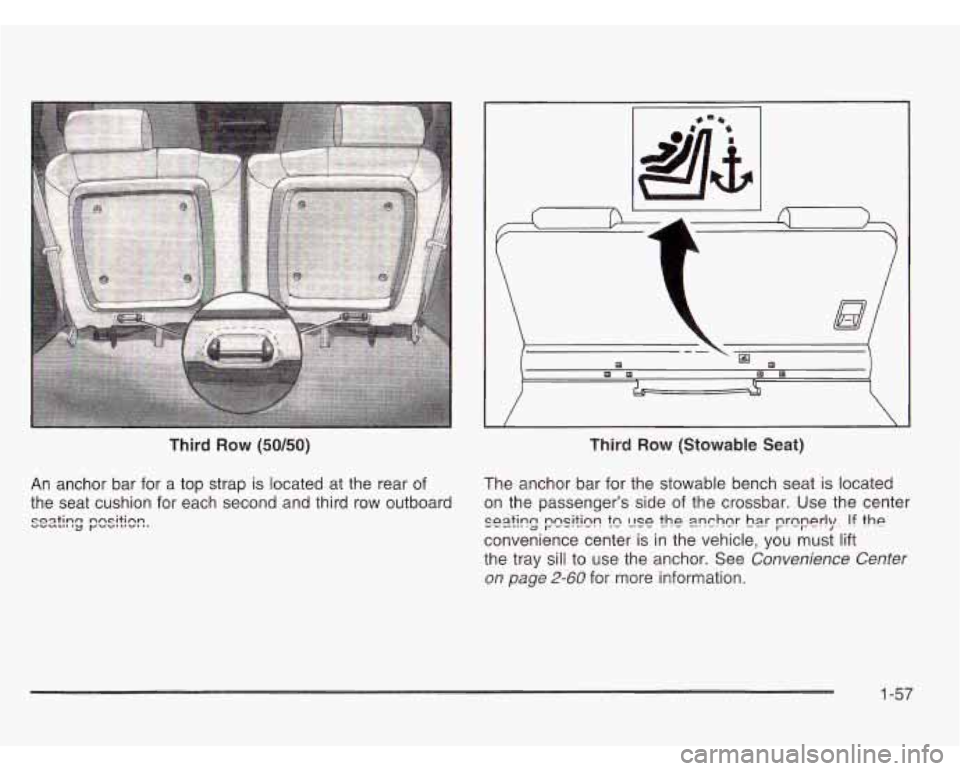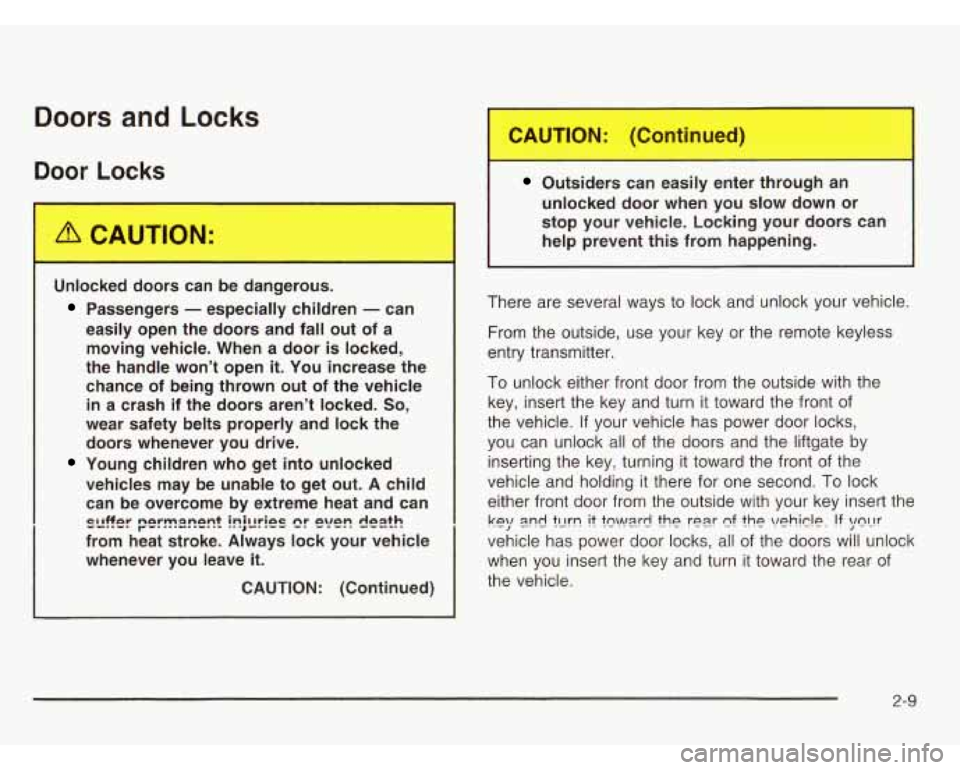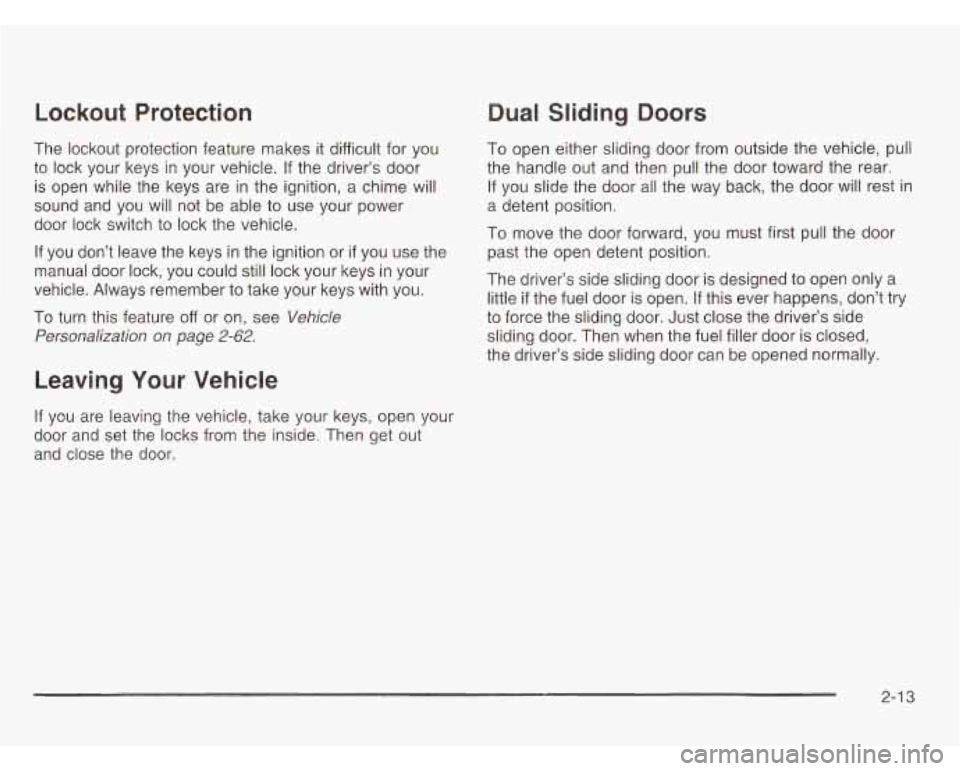tow OLDSMOBILE SILHOUETTE 2003 User Guide
[x] Cancel search | Manufacturer: OLDSMOBILE, Model Year: 2003, Model line: SILHOUETTE, Model: OLDSMOBILE SILHOUETTE 2003Pages: 466, PDF Size: 21.55 MB
Page 58 of 466

Child Restraint Systems
The body structure of a young child is ,,ite
unlike that of an adult or older child, for whom
the safety belts are designed.
A young child’s
hip bones are still
so small that the vehicle’s
regular safety belt may not remain low on the
hip bones, as
it should. Instead, it may settle
up around the child’s abdomen.
In a crash,
the belt would apply force
on a body area
that’s unprotected by any bony structure.
This alone could cause serious or fatal injuries. Young children always should be
secured in appropriate child restraints.
An infant car bed (A), a special bed made for use in a
to restrain or position a child on a contmuous flat
surface. Make sure that the infant’s head rests toward
the center of the vehicle.
mdc- \/shic!s, is 21 infb~t mc,t-eint c
ctam dacinnd ‘:“” ---* J”--
1-51
Page 64 of 466

Third Row (50/50)
An anchor bar for a top strap is located at the rear of
the seat cushion for each second and third row outboard
vuuIll1y yvulrl". .. coQtinn nncitinn
I
Third Row (Stowable Seat)
The anchor bar for the stowable bench seat is located
on the passenger's side of the crossbar. Use the center
convenience center
is in the vehicle, you must lift
the tray sill to use the anchor. See Convenience Center
on page
2-60 for more information.
se2tincJ yc!sitinr! tc! llse the anchnr har prnper!y. !f the
1-57
Page 81 of 466

What Makes an Air Bag Inflate?
In an impact of sufficient severity, the air bag sensing
system detects that the vehicle is in a crash. For both
frontal and side impact air bags, the sensing system
triggers a release of gas from the inflator, which inflates
the air bag. The inflator, the air bag and related hardware
are all part of the air bag modules inside the steering
wheel, the instrument panel, and the side of the front
seatbacks closest to the door.
How Does an Air Bag Restrain?
In moderate to severe frontal or near frontal collisions,
even belted occupants can contact the steering wheel
or the instrument panel. In moderate to severe side
collisions, even belted occupants can contact the inside
of the vehicle. The air bag supplements the protection
provided by safety belts. Air bags distribute the force
of the impact more evenly over the occupant’s
upper body, stopping the occupant more gradually.
But the frontal air bags would not help you in many
types of collisions, including rollovers, rear impacts, and
many side impacts, primarily because an occupant’s
motion is not toward the air bag. Side impact air bags
would not help you
in many types of collisions,
including frontal or near frontal collisions, rollovers, and
rear impacts, primarily because an occupant’s motion is not toward those air
bags. Air bags should never be
regarded as anything more than a supplement to
safety belts, and then only in moderate to severe frontal
or near-frontal collisions for the driver’s and right front
passenger’s frontal air bags, and only in moderate
to severe side collisions for the driver’s and right front
passenger’s side impact air bag.
What Will You See After an Air Bag
Inflates?
After the air bag inflates, it quickly deflates, so quickly
that some people may not even realize the air bag
inflated. Some components of the air bag module will be
hot for a short time. These components include the
steering wheel hub for the driver’s frontal air bag and the
instrument panel for the right front passenger’s frontal
air bag. For vehicles with side impact air bags, the side
of the seatback closest to the driver’s and/or right
front passenger’s door will be hot. The parts of the bag
that come into contact with you may be warm, but
not too hot to touch. There will be some smoke and dust
coming from the vents in the deflated air bags. Air bag
inflation doesn’t prevent the driver from seeing or
being able to steer the vehicle, nor does it stop people
from leaving the vehicle.
1 -74
Page 94 of 466

Doors and Locks
pAAu Locks
I
U xked doors can be angerous.
Passengers - especially children - can
easily open the doors and fall out of a moving vehicle. When a door
is locked,
the handle won't open
it. You increase the
chance
of being thrown out of the vehicle
in a crash if the doors aren't locked.
So,
wear safety belts properly and lock the
doors whenever you drive.
vehicles may be unable to get out. A child
can be overcome by extreme heat and can
from heat stroke. Always lock your vehicle
whenever you leave
it.
CAUTION: (Continued)
Young children who get into unlocked
s~ffer nnrmannnt inilwinc ~r pgn +~fh P" *."-s---.- "-'1-' ---
Outsiders can easily enter through an
unlocked door when you slow down or
stop your vehicle. Locking your doors can
help prevent this from happening.
There are several ways to lock and unlock your vehicle.
From the outside, use your key or the remote keyless
entry transmitter.
To unlock either front door from the outside .with the
key, insert the key and turn it toward the front of
the vehicle. If your vehicle has power door locks,
you can unlock all of the doors and the liftgate by
inserting the key, turning it toward the front of the
vehicle and holding it there for one second.
To lock
either front door from the outside with your key insert the
vehicle has power door locks, all of the doors will unlock
when you insert the key and turn it toward the rear of
the vehicle.
key 2nd turn it tn?ncxc! the re2r e! the ?/ehIc!e. !f yxrr
2-9
Page 98 of 466

Lockout Protection
The lockout protection feature makes it difficult for you
to lock your keys in your vehicle.
If the driver’s door
is open while the keys are in the ignition, a chime will
sound and you will not be able to use your power
door lock switch to lock the vehicle.
If you don’t leave the keys in the ignition or if you use the
manual door lock, you could still lock your keys in your
vehicle. Always remember to take your keys with you.
To turn this feature off or on, see
Vehicle
Personalization
on page 2-62.
Leaving Your Vehicle
If you are leaving the vehicle, take your keys, open your
door and set the locks from the inside. Then get out
and close the door.
Dual Sliding Doors
To open either sliding door from outside the vehicle, pull
the handle out and then pull the door toward the rear.
If you slide the door all the way back, the door will rest in
a detent position.
To move the door forward, you must first pull the door
past the open detent position.
The driver’s side sliding door
is designed to open only a
little
if the fuel door is open. If this ever happens, don’t try
to force the sliding door. Just close the driver’s side sliding door. Then when the fuel filler door is closed,
the driver’s side sliding door can be opened normally.
2-1 3
Page 105 of 466

If your vehicle is facing c-- vnward on a steep
grade
(15 percent or more), the door may not
stay open and could slam shut, possibly
injuring someone.
To make sure the door does
not slam shut, turn on the power sliding door
feature. Then if the door closes,
it will close
under the control of the power door system.
If you want to close the power sliding door(s) when
the override switch(es) is turned
off, pull the inside or
outside handle or the edge
of the door. Move the
door about
4 inches (10 cm) toward the closed position
and release it. The door will close completely and
latch for you.
To close the power sliding door(s) when the override
switch(es) is turned on, pull the inside or outside handle
and slide the door all the way forward to the latched
position.
2-20
Page 117 of 466

Starting and Operating Your
Vehicle
New Vehicle Break-In
Notice: Your vehicle doesn’t need an elaborate
“break-in.” But
it will perform better in the long run
if you follow these guidelines:
Don’t drive at any one speed - fast or
slow
- for the first 500 miles (805 km).
Don’t make full-throttle starts.
Avoid making hard stops for the first 200 miles
(322 km) or so. During this time your new
brake linings aren’t yet broken
in. Hard stops
with new linings can mean premature wear and
earlier replacement.
Follow this breaking-in
guideline every time you get new brake linings.
Don’t tow a trailer during break-in. See “Towing
a Trailer”
in the Index for more information.
Ignition Positions
With the key in the ignition, you can turn it to five
different positions.
A
A E
A (ACCESSORY): This is the position in which you can
operate your electrical accessories. Press in the ignition
switch
as you turn the top of the key toward you.
2-32
Page 118 of 466

B (LOCK): This is the only position from which you
can remove the key. This position locks your ignition,
steering wheel and transaxle.
Notice: If your key seems stuck in LOCK and you
can’t turn
it, be sure you are using the correct key;
if
so, is it all the way in? If it is, then turn the
steering wheel left and right while you turn the key hard. Turn the key only with your hand. Using a
tool to force
it could break the key or the ignition
switch. If none
of these works, then your vehicle
needs service.
C (OFF): This position unlocks the ignition, steering
wheel and transaxle but, does not send power to
any accessories. Use this position
if your vehicle
must be pushed or towed, but never try
to push-start
your vehicle.
D (RUN): This is the position to which the switch returns
after you start your engine and release the ignition key.
This is the position for driving. Even when the engine is
not running, you can use RUN to operate your electrical
accessories and
to display some instrument panel
warning lights.
E (START): This position starts the engine. When the
engine starts, release the ignition key. The switch
will return to RUN for normal driving.
If the engine is not running, ACCESSORY and RUN
are positions that allow you to operate your electrical
accessories, such as the radio.
Retained Accessory Power (RAP)
With RAP, the power windows, power rear quarter
windows, audio system and the automatic level control
will continue to work up to
10 minutes after the
ignition key is turned to
OFF and none of the doors
are opened.
2-33
Page 121 of 466

Automatic Transaxle Operation
Maximum engine speed is limited when you’re in
PARK (P) or NEUTRAL
(N), to protect driveline
components from improper operation.
There are several different positions for your shift lever
PARK (P): This gear position locks your front wheels.
It’s the best position to use when you start your
engine because your vehicle can’t move easily.
Ensure the shift lever is fully in PARK (P) before starting
the engine. Your vehicle has an automatic transaxle shift
lock control system. You have to fully
apply your regular
brakes
before you can shift from PARK (P) when the
ignition key is in RUN.
As you step on the brake pedal,
while in PARK
(P), you may hear a click from the solenoid
of the system. This ensures that the system is operating
properly.
If you cannot shift out of PARK (P), ease pressure on
the shift lever - push the shift lever all the way into
PARK (P) as you maintain brake application. Then move
the shift lever into the gear you wish. See Shifting
Out
of Park (P) on page 2-42.
It is dangerous to get out of your vehicle if the
shift lever is not fully in PARK (P) with the
parking brake firmly
set. Your vehicle can roll.
Don’t leave your vehicle when the engine is
running unless you have to. If you have left the
engine running,
the vehicle can move suddenly.
You or others could be injured. To be sure your
vehicle won’t move, even when you’re on fairly
level ground, always set your parking brake and
move the
shift lever to PARK (P). See “Shifting
Into Park (P)”
in the Index. If you’re pulling a
trailer, see “Towing a Trailer” in the Index.
2-36
Page 122 of 466

REVERSE (R): Use this gear to back up.
Notice: Shifting to REVERSE (R) while your vehicle
is moving forward could damage your transaxle.
Shift to REVERSE
(R) only after your vehicle
is stopped.
To rock your vehicle back and forth to get out of snow,
ice or sand without damaging your transaxle, see
If You Are Stuck: In Sand, Mud, Ice or Snow on
page 4-30.
NEUTRAL (N): In this position, your engine doesn’t
connect with the wheels. To restart when you’re already
moving, use NEUTRAL
(N) only. Also, use NEUTRAL (N)
when your vehicle is being towed.
Shifting into a drive gear while your engine
Unless your foot
is firmly on the brake pedal,
your vehicle could move very rapidly. You
could lose control and
hit people or objects.
Don’t shift into a drive gear while your engine
is racing.
“rqcjng” (running 3t high speed) i$ dangP?rQl!s
Notice: Damage to your transaxle caused by
shifting into a drive gear with the engine racing
isn’t covered by your warranty.
AUTOMATIC OVERDRIVE (D): This position is for
normal driving. If you need more power for passing,
and you’re:
Going less than 35 mph (55 km/h), push your
Going about 35 mph (55 km/h) or more, push the
You’ll shift down to the next gear and have more power.
Notice; If your vehicle seems to start up rather
slowly, or if
it seems not to shift gears as you go
faster, something may be wrong with a transaxle
system sensor. If you drive very far that way,
your vehicle can be damaged.
So, if this happens,
.lave your vehicle serviced right away. Until then,
you can use SECOND
(2) when you are driving
less than
35 mph (55 km/h) and AUTOMATIC
accelerator pedal
about halfway down.
accelerator all the way down. n\~nnn~
= In s-” L:-L-” -.......A. w v LnurlI Y L \YI tui 1 utyt IC# apr;r?wa.
2-37